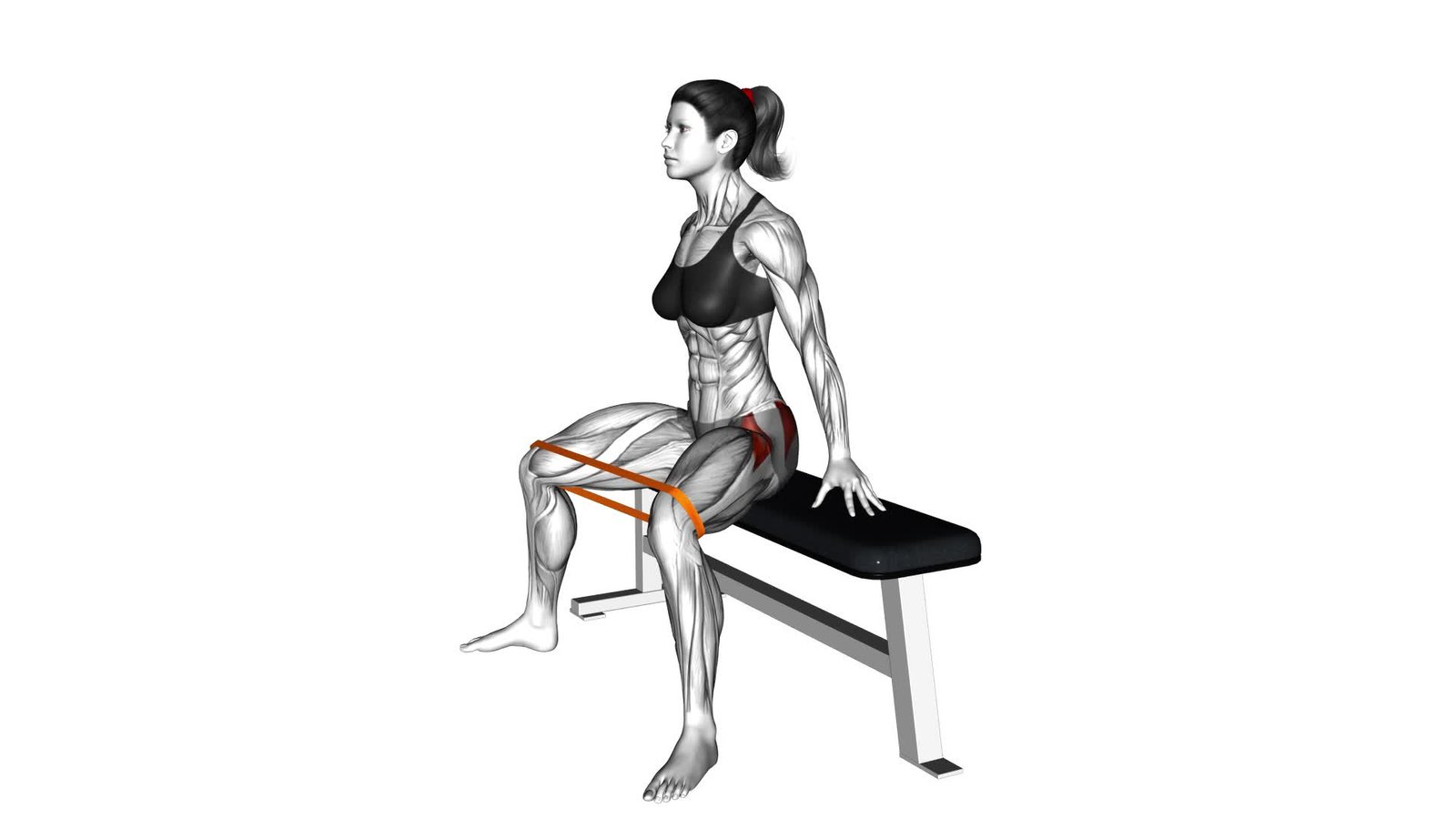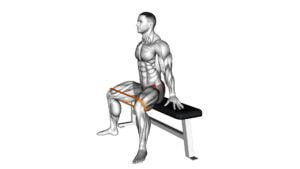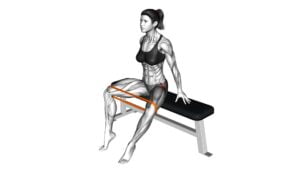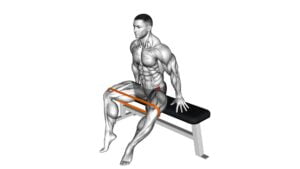Resistance Band Seated Hip Abduction (VERSION 2) (female) – Video Exercise Guide & Tips

Looking to strengthen your hip muscles? Check out this video exercise guide for Resistance Band Seated Hip Abduction (Version 2) designed specifically for females.
Watch This Exercise Video
With step-by-step instructions and helpful tips, you'll learn the proper form and technique to get the most out of this exercise.
Plus, discover modifications for beginners and advanced variations for added challenge.
Get ready to maximize your hip abduction workout and achieve your fitness goals with this informative and precise guide.
Let's get started!
Key Takeaways
- Resistance band seated hip abduction improves hip strength, stability, and overall hip stability
- It helps prevent injuries in the hip area by strengthening the glutes, hip flexors, and outer thigh muscles
- Proper form and technique include sitting upright on a chair or bench, engaging core muscles, and controlling the movement against the resistance of the band
- Choosing the right resistance band based on current strength and gradually increasing resistance as strength improves is important for a challenging yet effective workout.
Benefits of Resistance Band Seated Hip Abduction
You can experience significant improvements in hip strength and stability by incorporating resistance band seated hip abduction into your workout routine. Regular exercise has numerous benefits for your overall health, and focusing on the hips can help prevent injuries in this area. The hip joint is responsible for supporting your body weight and facilitating movement, making it crucial to keep it strong and stable.
By regularly performing resistance band seated hip abduction exercises, you can strengthen the muscles surrounding the hip joint, including the glutes, hip flexors, and outer thigh muscles. This increased strength can enhance your overall hip stability, reducing the risk of hip injuries during physical activities.
Furthermore, incorporating resistance band exercises into your routine can improve your balance and coordination. These exercises challenge your muscles in different planes of motion, helping you develop better control and stability in your hips.
In addition to injury prevention, resistance band seated hip abduction can also enhance your athletic performance. Strong hip muscles are essential for activities such as running, jumping, and squatting, allowing you to generate more power and improve your overall performance.
To reap the full benefits of resistance band seated hip abduction, it's important to perform the exercises with proper form and technique. By maintaining correct alignment and engaging the targeted muscles, you can maximize the effectiveness of the exercise and minimize the risk of injury.
Proper Form and Technique
Maintaining proper form and technique is essential for effectively performing resistance band seated hip abduction exercises. To maximize your results and prevent injuries, here are some important tips to keep in mind:
- Position yourself correctly:
- Sit upright on a chair or bench with your feet flat on the floor, shoulder-width apart.
- Place the resistance band just above your knees.
- Engage your core:
- Before starting the exercise, activate your core muscles by drawing your belly button in towards your spine.
- This will help stabilize your body and protect your lower back.
- Keep a neutral spine:
- Throughout the exercise, maintain a straight back and avoid rounding your shoulders.
- This will ensure proper alignment and reduce the risk of strain on your spine.
- Control the movement:
- Slowly and steadily, open your legs out to the sides against the resistance of the band.
- Avoid using momentum or jerking motions.
- Control the movement both when opening and closing your legs.
By following these tips, you'll perform resistance band seated hip abduction exercises with proper form and technique, maximizing your results and minimizing the risk of injuries.
Now, let's move on to the next section and learn about choosing the right resistance band for this exercise.
Choosing the Right Resistance Band
To choose the right resistance band for this exercise, consider the level of resistance that best suits your fitness goals and abilities. Resistance bands come in different levels of resistance, ranging from light to heavy. The level of resistance determines the amount of tension the band provides and how challenging the exercise will be.
When choosing the best resistance level, it's important to assess your current strength and fitness level. If you're a beginner or have low strength, start with a lighter resistance band. As you progress and become stronger, you can gradually increase the resistance to continue challenging your muscles.
There are different types of resistance bands available, including loop bands, tube bands, and figure-eight bands. Loop bands are versatile and can be used for a variety of exercises, while tube bands have handles that provide a comfortable grip. Figure-eight bands are great for lower body exercises like hip abduction.
It is essential to choose a resistance band that's appropriate for your exercise and goals. Using a band with too much resistance can lead to muscle strain or injury, while using one with too little resistance may not provide enough challenge to effectively strengthen your muscles. Select a resistance band that allows you to perform the exercise with proper form and technique while still feeling challenged.
Modifications for Beginners
To modify this exercise for beginners, use a lighter resistance band that provides less tension and allows for a more manageable challenge. Here are four modifications that can help beginners get started with the resistance band seated hip abduction exercise:
- Start with a shorter range of motion: Instead of lifting your leg all the way up, begin by lifting it just a few inches off the ground. This will help you build strength and avoid straining your muscles.
- Use a chair for support: If you find it difficult to maintain your balance while performing the exercise, place a chair next to you and hold onto it for support. This will help you stabilize your body and focus on the movement.
- Perform the exercise lying down: If sitting on a chair is uncomfortable for you, try performing the exercise while lying down on your side. This modification allows you to target the same muscles without putting pressure on your lower back.
- Gradually increase resistance: As you become more comfortable with the exercise, gradually increase the tension of the resistance band. This will help you continue challenging your muscles and progress in your fitness journey.
Advanced Variations for Added Challenge
Now that you've mastered the basic seated hip abduction exercise with resistance bands, it's time to take it up a notch with advanced variations.
These variations are designed to challenge your muscles even further and provide progressive resistance options.
Progressive Resistance Options
You can increase the difficulty of the Resistance Band Seated Hip Abduction exercise by incorporating advanced variations. Here are four progressive resistance options to challenge your muscles and maximize muscle activation:
- Increase the resistance: Use a stronger resistance band to provide more tension and resistance for your hip muscles.
- Add ankle weights: Attach ankle weights to your legs to increase the workload on your hip abductor muscles.
- Perform single-leg hip abductions: Instead of using both legs together, perform the exercise with one leg at a time. This will intensify the challenge on your hip muscles.
- Incorporate a stability ball: Sit on a stability ball instead of a chair to engage your core and challenge your balance while performing the hip abductions.
Increased Difficulty for Experts
To further challenge experienced individuals, incorporate these advanced variations to increase the difficulty of the Resistance Band Seated Hip Abduction exercise.
If you're looking to ramp up the intensity and take your workout to the next level, try these advanced modifications.
First, increase the intensity by using a heavier resistance band or adding more resistance to your current band. This will require your hip muscles to work harder and will help you build strength and endurance.
Additionally, you can perform the exercise on an unstable surface, such as a balance disc or Bosu ball. This will challenge your core stability and engage more muscles in your lower body.
Finally, you can combine the seated hip abduction with other exercises, such as bicep curls or shoulder presses, to create a full-body workout.
These advanced modifications will push your limits and help you achieve your fitness goals.
Tips for Maximizing Your Hip Abduction Workout
To maximize your hip abduction workout, it's crucial to focus on proper form techniques. Ensure that you maintain a stable seated position and engage your core muscles throughout the exercise.
Additionally, gradually increase the resistance levels of your resistance band to continually challenge your hip muscles and promote growth and strength.
Proper Form Techniques
To maximize your hip abduction workout, make sure to maintain proper form techniques. Here are four essential tips to help you get the most out of your exercises:
- Keep your back straight: Avoid leaning forward or backward during the movement to ensure you're targeting the correct muscles and maintaining proper alignment.
- Engage your core: Activating your core muscles will provide stability and support throughout the exercise, allowing you to perform the movement more effectively.
- Control the resistance band: Maintain tension in the band throughout the entire range of motion. This will challenge your muscles and enhance the effectiveness of the exercise.
- Avoid excessive swinging: Keep your movements controlled and avoid using momentum to complete the exercise. This will ensure that you're solely relying on your hip muscles for the movement.
Increasing Resistance Levels
To maximize the effectiveness of your hip abduction workout and continue challenging your muscles, it's important to gradually increase the resistance levels of your exercises.
This concept, known as progressive overload, is key to making continuous gains in strength and muscle tone.
When it comes to resistance band exercises, there are several ways to increase the resistance levels.
One option is to use a band with a higher resistance level. This will make the exercise more challenging and help you build stronger hip muscles.
Another option is to add more bands to increase the total resistance. For example, you can double up on bands or combine bands of different resistance levels.
Finally, you can also increase the resistance by reducing the length of the band. This will create more tension and require more effort from your muscles.
Frequently Asked Questions
How Many Sets and Repetitions Should I Do for Resistance Band Seated Hip Abduction?
To get the most out of resistance band seated hip abduction exercises, it's important to focus on proper form.
Start by sitting on a chair or bench with your back straight and feet flat on the floor.
Place a resistance band around your thighs, just above your knees.
Open your legs out to the sides, against the resistance of the band, and then bring them back together.
Aim for 2-3 sets of 10-15 repetitions to effectively target your hip muscles.
Can Resistance Band Seated Hip Abduction Help With Strengthening the Glute Muscles?
Resistance band seated hip abduction is an excellent exercise for strengthening your glute muscles. By using a resistance band, you can increase the intensity of the workout and target your glutes more effectively.
This exercise helps to activate and engage your glute muscles, leading to improved strength and stability.
If you don't have access to resistance bands, there are alternative exercises you can do to strengthen your glutes, such as squats, lunges, and hip thrusts. These exercises can be done without any equipment and still provide great results.
Is Resistance Band Seated Hip Abduction a Good Exercise for Improving Hip Stability?
Resistance band seated hip abduction is an excellent exercise for improving hip stability. By using resistance bands, you can add extra resistance to target and strengthen the muscles responsible for hip stability.
This exercise offers numerous benefits, such as increased hip strength, improved balance, and enhanced overall stability.
There are also different variations of seated hip abduction exercises that can be done using resistance bands, allowing you to customize your workout and target specific muscle groups.
Incorporating resistance band exercises into your routine can greatly benefit your hip stability.
What Are Some Common Mistakes to Avoid While Performing Resistance Band Seated Hip Abduction?
When performing resistance band seated hip abduction, it's important to be aware of common mistakes to avoid.
To maintain proper form and technique, make sure you don't let your knees collapse inward or allow your upper body to lean forward. Keep your back straight and engage your core muscles throughout the exercise.
Also, avoid using too much tension in the resistance band, as this can lead to improper alignment and potential injury.
Can Resistance Band Seated Hip Abduction Be Done by People With Knee or Hip Injuries?
Resistance band seated hip abduction can be modified for people with knee or hip injuries. If you have any concerns, it's always best to consult with a healthcare professional before attempting this exercise. They can provide guidance on how to adapt the movement to accommodate your injury.
Additionally, resistance band seated hip abduction is suitable for beginners as it allows for controlled and gradual progression. Just remember to start with a lighter resistance band and focus on proper form.
Conclusion
In conclusion, resistance band seated hip abduction is a highly effective exercise for targeting and strengthening the hip muscles. By using the proper form and technique, choosing the right resistance band, and modifying the exercise for your fitness level, you can maximize the benefits of this workout.
Additionally, advanced variations can be incorporated to add an extra challenge. Remember to consult with a fitness professional if needed and always listen to your body to prevent any injuries.
Get ready to enhance your hip abduction strength and improve your overall fitness.

Author
Years ago, the spark of my life’s passion ignited in my mind the moment I stepped into the local gym for the first time. The inaugural bead of perspiration, the initial endeavor, the very first surge of endorphins, and a sense of pride that washed over me post-workout marked the beginning of my deep-seated interest in strength sports, fitness, and sports nutrition. This very curiosity blossomed rapidly into a profound fascination, propelling me to earn a Master’s degree in Physical Education from the Academy of Physical Education in Krakow, followed by a Sports Manager diploma from the Jagiellonian University. My journey of growth led me to gain more specialized qualifications, such as being a certified personal trainer with a focus on sports dietetics, a lifeguard, and an instructor for wellness and corrective gymnastics. Theoretical knowledge paired seamlessly with practical experience, reinforcing my belief that the transformation of individuals under my guidance was also a reflection of my personal growth. This belief holds true even today. Each day, I strive to push the boundaries and explore new realms. These realms gently elevate me to greater heights. The unique combination of passion for my field and the continuous quest for growth fuels my drive to break new ground.







